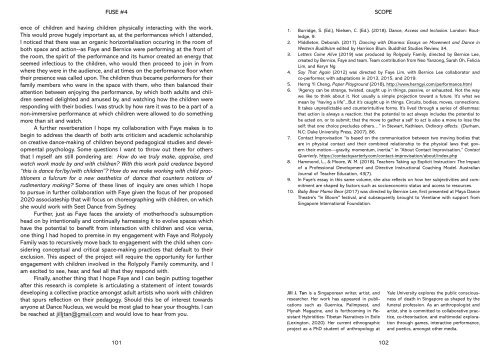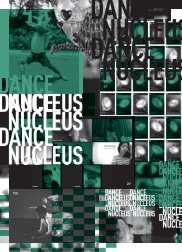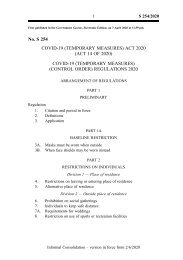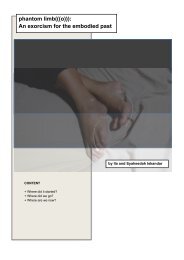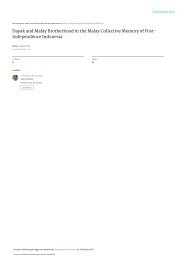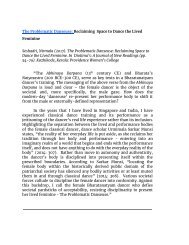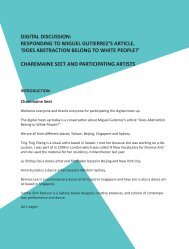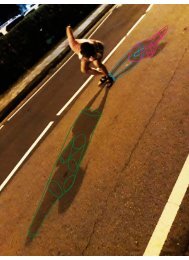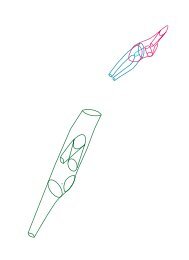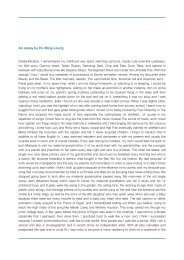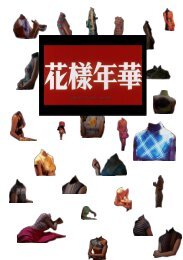FUSE#4
FUSE is a bi-annual publication that documents the projects at Dance Nucleus .
FUSE is a bi-annual publication that documents the projects at Dance Nucleus .
You also want an ePaper? Increase the reach of your titles
YUMPU automatically turns print PDFs into web optimized ePapers that Google loves.
FUSE #4<br />
ence of children and having children physically interacting with the work.<br />
This would prove hugely important as, at the performances which I attended,<br />
I noticed that there was an organic horizontalisation occuring in the room of<br />
both space and action--as Faye and Bernice were performing at the front of<br />
the room, the spirit of the performance and its humor created an energy that<br />
seemed infectious to the children, who would then proceed to join in from<br />
where they were in the audience, and at times on the performance floor when<br />
their presence was called upon. The children thus became performers for their<br />
family members who were in the space with them, who then balanced their<br />
attention between enjoying the performance, by which both adults and children<br />
seemed delighted and amused by, and watching how the children were<br />
responding with their bodies. I was struck by how rare it was to be a part of a<br />
non-immersive performance at which children were allowed to do something<br />
more than sit and watch.<br />
A further reverberation I hope my collaboration with Faye makes is to<br />
begin to address the dearth of both arts criticism and academic scholarship<br />
on creative dance-making of children beyond pedagogical studies and developmental<br />
psychology. Some questions I want to throw out there for others<br />
that I myself am still pondering are: How do we truly make, appraise, and<br />
watch work made by and with children? With this work paid credence beyond<br />
“this is dance for/by/with children”? How do we make working with child practitioners<br />
a fulcrum for a new aesthetics of dance that counters notions of<br />
rudimentary making? Some of these lines of inquiry are ones which I hope<br />
to pursue in further collaboration with Faye given the focus of her proposed<br />
2020 associateship that will focus on choreographing with children, on which<br />
she would work with Seet Dance from Sydney.<br />
Further, just as Faye faces the anxiety of motherhood’s subsumption<br />
head on by intentionally and continually harnessing it to evolve spaces which<br />
have the potential to benefit from interaction with children and vice versa,<br />
one thing I had hoped to premise in my engagement with Faye and Rolypoly<br />
Family was to recursively move back to engagement with the child when considering<br />
conceptual and critical space-making practices that default to their<br />
exclusion. This aspect of the project will require the opportunity for further<br />
engagement with children involved in the Rolypoly Family community, and I<br />
am excited to see, hear, and feel all that they respond with.<br />
Finally, another thing that I hope Faye and I can begin putting together<br />
after this research is complete is articulating a statement of intent towards<br />
developing a collective practice amongst adult artists who work with children<br />
that spurs reflection on their pedagogy. Should this be of interest towards<br />
anyone at Dance Nucleus, we would be most glad to hear your thoughts. I can<br />
be reached at jilljtan@gmail.com and would love to hear from you.<br />
1. Burridge, S. (Ed.), Nielsen, C. (Ed.). (2018). Dance, Access and Inclusion. London: Routledge,<br />
9.<br />
2. Middleton, Deborah. (2017). Dancing with Dharma: Essays on Movement and Dance in<br />
Western Buddhism edited by Harrison Blum. Buddhist Studies Review, 34.<br />
3. Letters Come Alive (2019) was produced by Rolypoly Family, directed by Bernice Lee,<br />
created by Bernice, Faye and team. Team contribution from Neo Yanzong, Sarah Oh, Felicia<br />
Lim, and Keryn Ng<br />
4. Say That Again (2012) was directed by Faye Lim, with Bernice Lee collaborator and<br />
co-performer, with adaptations in 2013, 2015, and 2019.<br />
5. Herng Yi Cheng, Paper Playground (2018), http://www.herngyi.com/performance.html<br />
6. “Agency can be strange, twisted, caught up in things, passive, or exhausted. Not the way<br />
we like to think about it. Not usually a simple projection toward a future. It’s what we<br />
mean by “having a life”...But it’s caught up in things. Circuits, bodies, moves, connections.<br />
It takes unpredictable and counterintuitive forms. It’s lived through a series of dilemmas:<br />
that action is always a reaction; that the potential to act always includes the potential to<br />
be acted on, or to submit; that the move to gather a self to act is also a move to lose the<br />
self; that one choice precludes others…” in Stewart, Kathleen, Ordinary affects. (Durham,<br />
N.C: Duke University Press, 2007), 86.<br />
7. Contact Improvisation “is based on the communication between two moving bodies that<br />
are in physical contact and their combined relationship to the physical laws that govern<br />
their motion—gravity, momentum, inertia.” in “About Contact Improvisation,” Contact<br />
Quarterly, https://contactquarterly.com/contact-improvisation/about/index.php<br />
8. Hammond, L., & Moore, W. M. (2018). Teachers Taking up Explicit Instruction: The Impact<br />
of a Professional Development and Directive Instructional Coaching Model. Australian<br />
Journal of Teacher Education, 43(7).<br />
9. In Faye’s essay in this same volume, she also reflects on how her subjectivities and commitment<br />
are shaped by factors such as socioeconomic status and access to resources.<br />
10. Baby Bear Mama Bear (2017) was directed by Bernice Lee, first presented at Maya Dance<br />
Theatre's "In Bloom" festival, and subsequently brought to Vientiane with support from<br />
Singapore International Foundation.<br />
Jill J. Tan is a Singaporean writer, artist, and<br />
researcher. Her work has appeared in publications<br />
such as Guernica, Palimpsest, and<br />
Mynah Magazine, and is forthcoming in Resistant<br />
Hybridities: Tibetan Narratives in Exile<br />
(Lexington, 2020). Her current ethnographic<br />
project as a PhD student of anthropology at<br />
SCOPE<br />
Yale University explores the public consciousness<br />
of death in Singapore as shaped by the<br />
funeral profession. As an anthropologist and<br />
artist, she is committed to collaborative practice,<br />
co-theorisation, and multimodal exploration<br />
through games, interactive performance,<br />
and poetics, amongst other media.<br />
101 102


